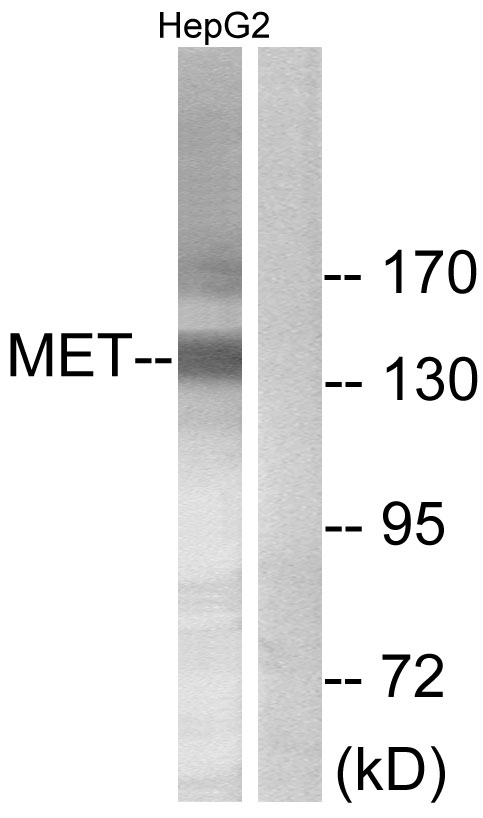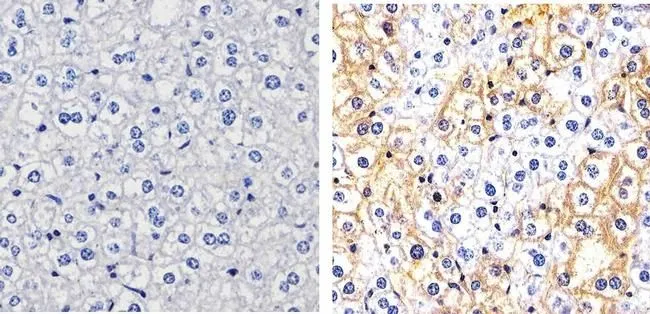c-Met antibody [C3], C-term
GTX100637
ApplicationsImmunoFluorescence, ImmunoPrecipitation, Western Blot, ImmunoCytoChemistry
Product group Antibodies
TargetMET
Overview
- SupplierGeneTex
- Product Namec-Met antibody [C3], C-term
- Delivery Days Customer9
- Application Supplier NoteWB: 1:500-1:3000. ICC/IF: 1:100-1:1000. IP: 1:100-1:500. *Optimal dilutions/concentrations should be determined by the researcher.Not tested in other applications.
- ApplicationsImmunoFluorescence, ImmunoPrecipitation, Western Blot, ImmunoCytoChemistry
- CertificationResearch Use Only
- ClonalityPolyclonal
- Concentration1.95 mg/ml
- ConjugateUnconjugated
- Gene ID4233
- Target nameMET
- Target descriptionMET proto-oncogene, receptor tyrosine kinase
- Target synonymsAUTS9, DA11, DFNB97, HGFR, RCCP2, c-Met, hepatocyte growth factor receptor, HGF receptor, HGF/SF receptor, SF receptor, proto-oncogene c-Met, scatter factor receptor, tyrosine-protein kinase Met
- HostRabbit
- IsotypeIgG
- Protein IDP08581
- Protein NameHepatocyte growth factor receptor
- Scientific DescriptionThe proto-oncogene MET product is the hepatocyte growth factor receptor and encodes tyrosine-kinase activity. The primary single chain precursor protein is post-translationally cleaved to produce the alpha and beta subunits, which are disulfide linked to form the mature receptor. Various mutations in the MET gene are associated with papillary renal carcinoma. Two transcript variants encoding different isoforms have been found for this gene. [provided by RefSeq]
- Storage Instruction-20°C or -80°C,2°C to 8°C
- UNSPSC12352203
References
- De Tomi E, Campagnari R, Orlandi E, et al. Upregulation of miR-34a-5p, miR-20a-3p and miR-29a-3p by Onconase in A375 Melanoma Cells Correlates with the Downregulation of Specific Onco-Proteins. Int J Mol Sci. 2022,23(3). doi: 10.3390/ijms23031647Read this paper
- Pang HH , Huang CY , Chou YW , et al. Bioengineering fluorescent virus-like particle/RNAi nanocomplexes act synergistically with temozolomide to eradicate brain tumors. Nanoscale. 2019,11(17):8102-8109. doi: 10.1039/c9nr01247hRead this paper
- Chen ST, Kuo TC, Liao YY, et al. Silencing of MUC20 suppresses the malignant character of pancreatic ductal adenocarcinoma cells through inhibition of the HGF/MET pathway. Oncogene. 2018,37(46):6041-6053. doi: 10.1038/s41388-018-0403-0Read this paper
- Pei YF, Yin XM, Liu XQ. TOP2A induces malignant character of pancreatic cancer through activating β-catenin signaling pathway. Biochim Biophys Acta Mol Basis Dis. 2018,1864(1):197-207. doi: 10.1016/j.bbadis.2017.10.019Read this paper
- Wang C, Tseng T, Jhang Y, et al. Loss of cell invasiveness through PKC-mediated syndecan-1 downregulation in melanoma cells under anchorage independency. Exp Dermatol. 2014,23(11):843-9. doi: 10.1111/exd.12550Read this paper
- Wu YM, Liu CH, Huang MJ, et al. C1GALT1 enhances proliferation of hepatocellular carcinoma cells via modulating MET glycosylation and dimerization. Cancer Res. 2013,73(17):5580-90. doi: 10.1158/0008-5472.CAN-13-0869Read this paper
- Lin WC, Tsai HF, Kuo SH, et al. Translocation of Helicobacter pylori CagA into Human B lymphocytes, the origin of mucosa-associated lymphoid tissue lymphoma. Cancer Res. 2010,70(14):5740-8. doi: 10.1158/0008-5472.CAN-09-4690Read this paper







![WB analysis of various samples using GTX14700 c-Met antibody [3i20(25H2)]. Lane 1 : mIMCD3 Lane 2 : Vero Lane 3 : 293 (HGF stimulated) Lane 4 : 293 (starved) Lane 5 : C6](https://www.genetex.com/upload/website/prouct_img/normal/GTX14700/GTX14700_20191203_WB_46_w_23060620_293.webp)
